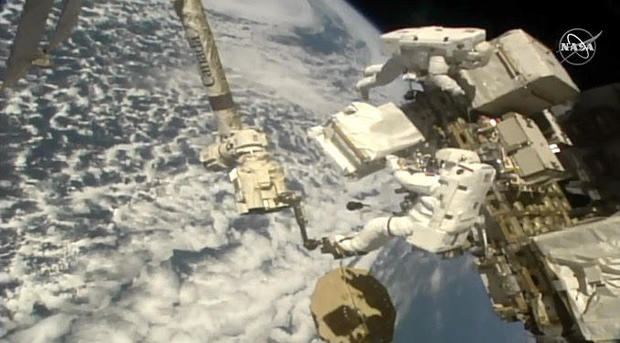Spacewalk updates (all times in EST):
- 8:19 a.m. (elapsed time: 1 hour, 48 minutes): Drew Morgan and Luca Parmitano have mounted a replacement 350-pound coolant pump module on the Alpha Magnetic Spectrometer (AMS) and connected power and data cables; the unit powered up normally and the astronauts are now beginning work to splice the module into eight coolant lines.
- 8:45 a.m. (elapsed time: 2 hours, 14 minutes): Parmitano has completed a multi-step procedure to splice in, or “swage,” the first of eight small AMS coolant lines to the newly installed pump module. “One down, seven to go,” mission control radioes the crew. These connections are critical to the success of the AMS repair and so far, the work is going smoothly.
- 9:50 a.m. (elapsed time: 3 hours 19 minutes): Parmitano, assisted by Morgan, has attached six coolant lines to the new pump module they mounted earlier on the Alpha Magnetic Spectrometer; two more lines must be connected, or swaged to fit, on the other side of the instrument to complete the primary tasks of today’s spacewalk.
- 10:50 a.m. (elapsed time: 4 hours 19 minutes): Working on the other side of the AMS, Parmitano is connecting a final two coolant lines to the AMS’s new pump module; these connections were considered especially tricky given the lines are very small and relatively fragile, but the crew has had no problems of any significance so far in the repair work.
- 11:13 a.m. (elapsed time: 4 hours 42 minutes): Parmitano and Morgan have finished connecting all eight CO2 coolant lines to the AMS pump module; with the primary objectives of today’s spacewalk complete, the astronauts now are carrying out a “get-ahead” task by installing an additional insulation blanket to help maintain proper temperatures.
After prepping their patient — a $2 billion cosmic ray detector — during two earlier spacewalks, two space station astronauts ventured back outside for a third outing Monday to perform what amounts to transplant surgery, installing replacement coolant pumps to revive the costly instrument and extend its life.
The work requires European Space Agency astronaut Luca Parmitano and NASA crewmate Drew Morgan to attach an intricate pump module to the 7.5-ton Alpha Magnetic Spectrometer and then splice it into eight thin coolant lines. A fourth spacewalk will be needed to check for leaks and to reattach insulation.
Trending News
The equipment was not designed to be serviced in orbit and the work is considered the most challenging project since spacewalks to repair and upgrade the Hubble Space Telescope.
Floating in the Quest airlock compartment, Parmitano and Morgan switched their spacesuits to battery power at 6:31 a.m. EST to officially kick off the 11th spacewalk so far this year, the 224th devoted to station assembly and maintenance and the third of four needed to repair the Alpha Magnetic Spectrometer.
For identification, Parmitano, call sign EV-1, is wearing a suit with red stripes and using helmet camera No. 11 while Morgan, EV-2, is wearing an unmarked suit equipped with “helmetcam” 18.
Launched in 2011, the AMS was built to study high-energy cosmic rays to glean clues about what happened to the antimatter presumably created during the big bang in equal measure with normal matter.
The AMS may also shed light on the nature of the unseen dark matter permeating the universe, possibly helping to explain the motions of galaxies and galactic clusters, and the dark energy that appears to be speeding up the expansion of the cosmos.
To achieve the required sensitivity, the AMS detectors must be chilled using carbon dioxide coolant pushed through the instrument in thin lines the width of a pencil. Originally designed to operate for just three years, the AMS was still collecting data after eight years, at which point a fourth and final coolant pump began failing.
To fix the system, engineers came up with a four-spacewalk plan to install a custom-built module containing four powerful pumps and a reservoir of fresh carbon dioxide coolant. Because the AMS was not designed to be serviced, engineers had to develop a variety of innovative tools and techniques to complete the job, requiring years of planning and training.
“Something that is really really cool for an astronaut is to actually be part of the development of an extravehicular activity (EVA),” Parmitano said during pre-flight training. “I’ve been lucky enough to have been part of the development team from the beginning, initially just as a consultant and then … as a test subject for some of the tools.
“We’re going to perform what could be considered open heart surgery on this amazing experiment,” Parmitano explained. “We’re going to cut tubes, and install a completely new pump to help the refrigeration work, keeping the magnet cold so the the Alpha Magnetic Spectrometer can work. This is really the first time any of these actions have been attempted.”
During spacewalks on November 15 and 22, Parmitano and Morgan removed a protective panel from the AMS, exposing the thermal control system. They then cut zip ties, pulled back insulation, cut through a line to vent residual coolant overboard and then cut eight coolant circulation lines. That permanently disabled the AMS and set the stage for Monday’s spacewalk.
“The third EVA is when we bring out the new pump system, we install that, and then we’ve got … eight tubes that we’re connecting,” said Brian Mader, an engineer at the Johnson Space Center who helped design the repair work. “It’s a piece of art. It’s really amazing how … the engineers figured out how to coil these tubes on the box.”
The module contains four small pumps, a spherical carbon dioxide tank, data and power cables. To splice it into the AMS thermal control system, Parmitano and Morgan will connect the eight previously cut coolant lines, one by one, effectively splicing, or “swaging,” them together using custom tools.
A fourth spacewalk will be required to carry out leak checks, make any adjustments that might be needed and then to re-install insulation. The final excursion is not yet scheduled and may be put on hold in the near term because of crew time needed for unloading visiting cargo ships and other higher-priority tasks.



